Related Content
- Jurisdiction
- Equitable Jurisdiction
- Venue
- Class action
- Class Representative
- Individual plaintiffs
- Defendant Scottish Power
- Defendant PacifiCorp
- Defendant PPM Energy Inc.
- Scottish Power and commercial wind power development
- Defendant Greenlight Energy Inc.
- Sale of Elk River Windfarms LLC
- Defendant The Empire District Electric Company
- The Empire District Electric Company and the Elk River Project
- The Flint Hills Ecoregion
- Flint Hills Endangered Flora & Fauna
- The Native Prairie Grasslands
- Tallgrass Prairie National Preserve
- Legislative History: Tallgrass Prairie National Preserve
- The Konza Prairie Site
- The LTER Program
- The Prairie Parkway
- The Flint Hills Scenic Byway
- Flint Hills Scenic Resources
- International recognition of the Tallgrass Prairie
- Birds of the Tallgrass Prairie
- Tourism
- Beneficial impacts of tourism
- Economic impacts of tourism
- The Blue Ridge Parkway Experience
- Serious, permanent & irreparable damage
- Wind turbines kill birds of prey
- Wind turbine development destroys habitat
- Wind turbine development damage
- Damage to quality of life
- Wind turbines: an economic catastrophe
- Tax avoidance and subsidies
- Voodoo economics of wind turbine power
- Catastrophic wind turbine failures
- The Electric Power Grid
- The prayer for relief
108.1 The following photographic exhibit is a fair and accurate representation of tourists observing the natural beauty of the area on Nordstrom Hill in the Flint Hills Tallgrass Prairie Regional Ecosystem.

108.1_tourists
109.1 National recognition of Kansas spectacular prairie landscapes is not yet as well established as that of the forested mountains of Vermont, the Everglades and similar areas. Appreciation for the native prairies in the Flint Hills is dramatically increasing throughout the country and beyond. With the recent establishment of the Tallgrass Prairie National Preserve as a unit of the National Park Service preservation system, the PBS Special, and research at Kansas State University/Konza Prairie, international recognition of this unique national and international natural resource treasure is quickly growing.
110. The Flint Hills Tallgrass Prairie Region should be developed and promoted to serve as an icon destination for Kansas. An icon epitomizes a specific habitat, and offers the public the opportunity to experience nature in its most authentic and unaltered form. An icon embodies the characteristics of the respective habitat, symbolizing nature in its most unadulterated or unmodified state. An icon transports the visitor back in time, offering a glimpse of the natural world as it once was.
110.1 The following photographic exhibit is a fair and accurate representation of Butcher Falls which offers a glimpse of the the natural world as it can still be in the Flint Hills Tallgrass Prairie Regional Ecosystem.
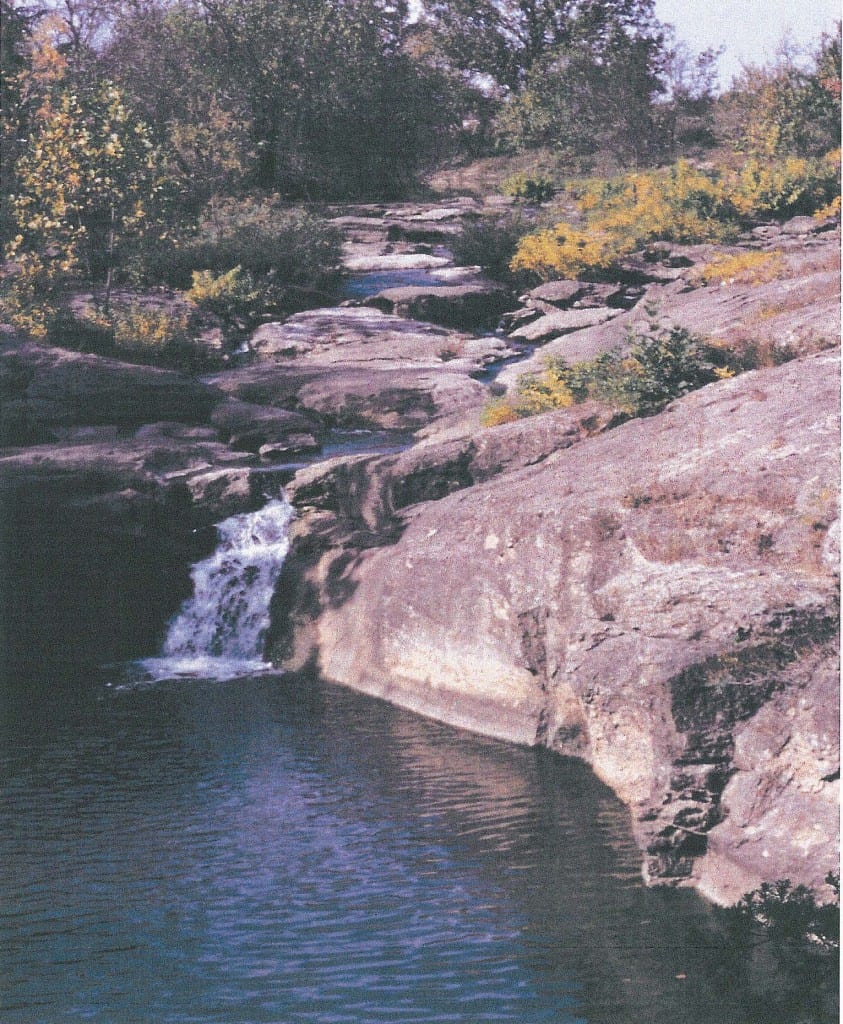
111. The opportunities for Kansas to enter the experiential tourism market are limited. Much of the Great Plains has been converted to commodity agriculture, and natural landscapes such as the Flint Hills are limited and discrete.
111.1 The following photographic exhibit is a fair and accurate representation of recreational riders and working ranch cowboys enjoying the Tallgrass Prairie viewshed. Agritourism and nature based experiential opportunities are appealing to a broadly diverse population of travelers.
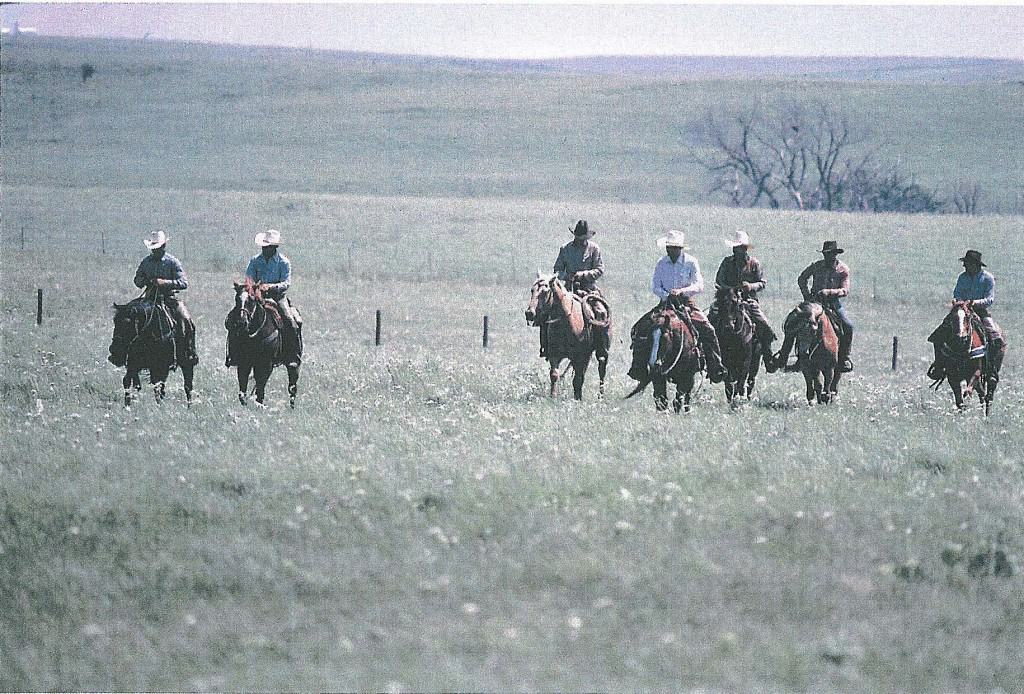
111.1 Recreatonal riders on a working ranch
113. The promise of nature tourism in the Flint Hills is more potent today than when originally voiced.
113.1 The ever-changing demographic landscape in_the United States has been dominated by the decades-long flood of rural residents into a relative handful of cities. Many of these urbanites, isolated from the natural and cultural resources that are still contained in rural America, are vacationing out of the cities in an effort to reconnect with their roots and those of their families.
114. Experiential travel is among the most significant travel sectors in the United States and one that continues to prodigiously expand. As such, it represents a significant economic driver for rural communities. Experiential tourism is contributing to the economic vitality of rural America and it does indeed “work for America.”
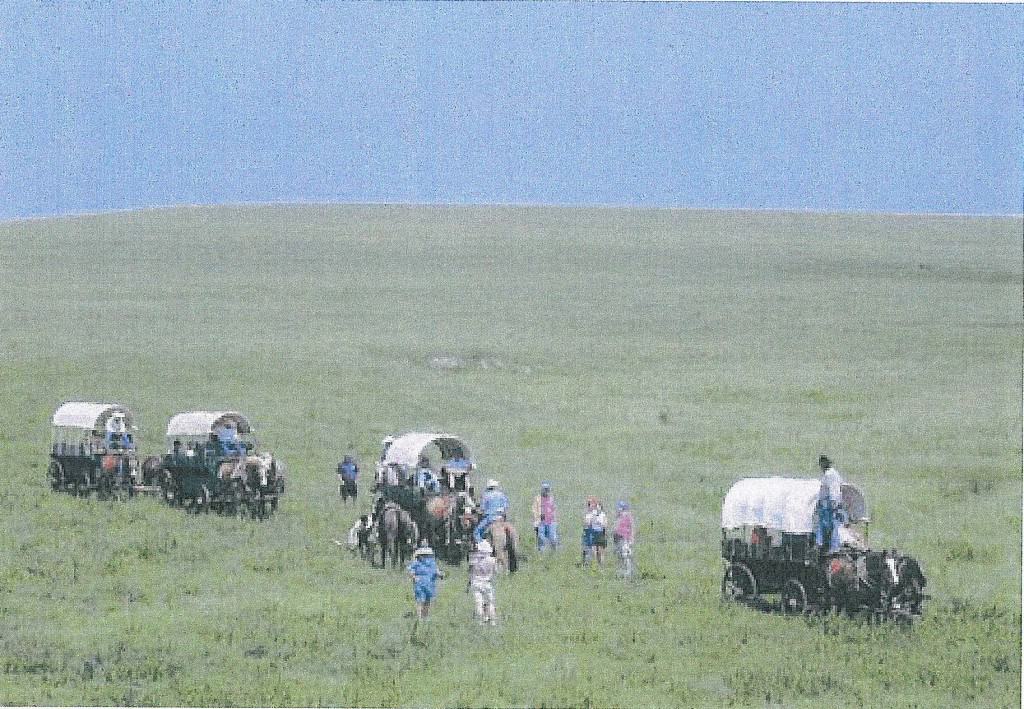
114.1 Nineteenth Century Wagon Train
114.2 In 1999 a class of consumers was defined who favor the consumption of experiences over traditional goods and services. They buy experiences to spend time enjoying memorable events that are personally engaging. Experiences are a distinct economic offering that occur when “a company intentionally uses services as the stage and goods as the props to engage an individual.”
114.3 According to the Travel Industry Association of America (TIA), “81% of U.S. adults who traveled in the past year, or 118 million, are considered historic/cultural travelers …for 30% of historic/cultural travelers, their destination choice was influenced by a specific historic or cultural event or activity.”
114.4 Outdoor recreation and/or visiting national or state parks are also one of the top activities for U.S. travelers taking leisure trips within the United States. One in four (27%) of these leisure trips includes some form of outdoor recreation and/or a visit to a national or state park.
115. The Flint Hills Regional Ecosystem provides one of the primary opportunities for the State of Kansas to develop experiential tourism, particularly eco-tourism, nature tourism, and agri-tourism.
116. Protecting the amenities of the Flint Hills Regional Ecosystem permits Kansas to capitalize on its unique national natural resource treasures which represent distinctive national and international differentiation opportunities for Kansas.
117. Nature tourism encompasses a broad range of travel interests and activities that elevate and enhance the individual experiences of the traveler. These interests are disparate, and bound together solely by the shared goal of each traveler to expand personal horizons. Personal enrichment, enlightenment, inspiration and engagement are among the primary motivators for these travelers. All of these motivators drive visitors to natural sites and protected areas. Relaxation and stress reduction are also important aims, but they are achieved indirectly through the experiences from the primary travel motivations.
111.1 Nature travel is estimated to be increasing at an annual rate between 10 percent and 30 percent. Between 40 percent and 60 percent of international visitors travel to enjoy and appreciate nature. More specifically, wildlife-associated recreation, as opposed to outdoor recreation in general, now involves millions of Americans in hunting, fishing, and a variety of non-consumptive activities such as birding, wildlife watching and nature photography.
117.2 The primary motivations of nature tourists are to enjoy sights, smells, sounds of nature; be outdoors; see wildlife species and behavior not seen before; get away from the demands of daily life at home and work; and enjoy family recreation.
117.3 Improved health, longer lifespans, retiring Baby Boomers, and a wealthier traveling public all support past trends that indicate growth rates in nature-based tourism activities of at least 10 percent annually and strongly favor a further increase in nature-based tourism .. Growth in wildlife watching has increased annually at rates far in excess of this.
117.4 Americans planning summer vacations will be staying closer to home and visiting destinations reachable by car. In addition to proximity, many travelers are looking for vacations that offer relaxation and a sense of escape to nature where outdoor activities including hiking, horseback riding and camping are available.
118. Destination brand building is all about developing a rich, relevant brand personality. The position of the Flint Hills Region as the icon for the Great Plains and as a land of both healthy natural resources and beauty will translate into the rational benefit of encountering history, heritage, and folklore. At the emotional level, visitors will experience awe of the elements and be rejuvenated by the experience.
Beneficial Impacts of Tourism Development
119. In addition to the traditional economic impacts from tourism-direct, indirect, and induced-ecologically and culturally sensitive tourism development can benefit the environmental health of a region.
119.1 The following photographic exhibit is a fair and accurate
representation of some of the Native American tradition of the region.
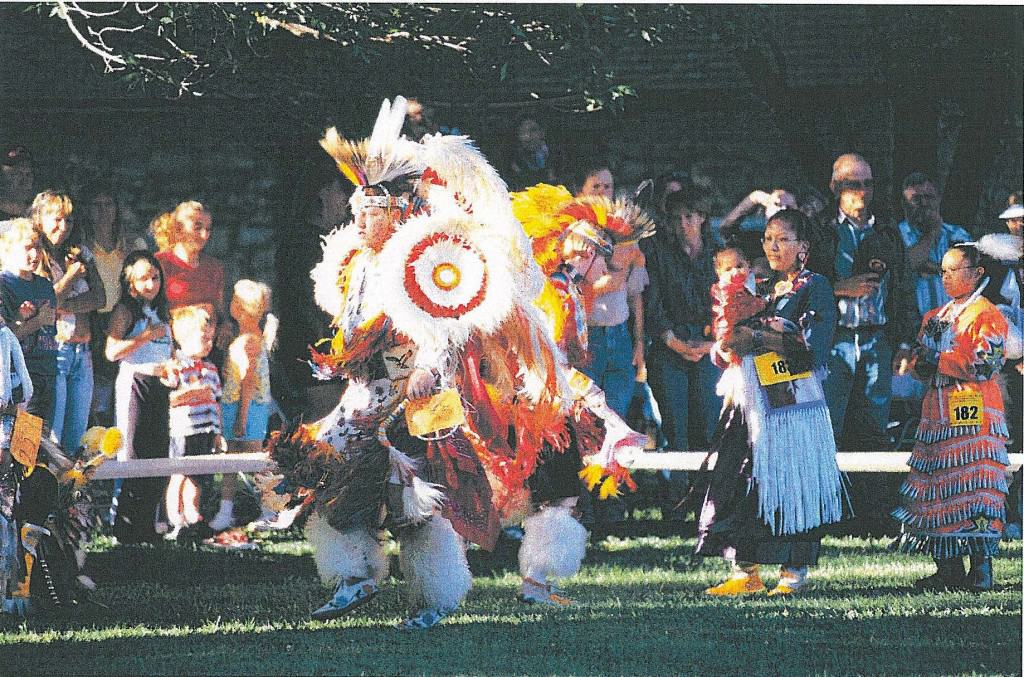
119.1_Native Americans
121. Experiential tourism development in Flint Hills communities will directly lead to an enhanced quality of life in the region. Amenities demanded by tourists also benefit residents and represent an amenity base upon which future economic development efforts may be constructed.
121.1 The following photographic exhibit is a fair and accurate representation of guests at a working ranch.
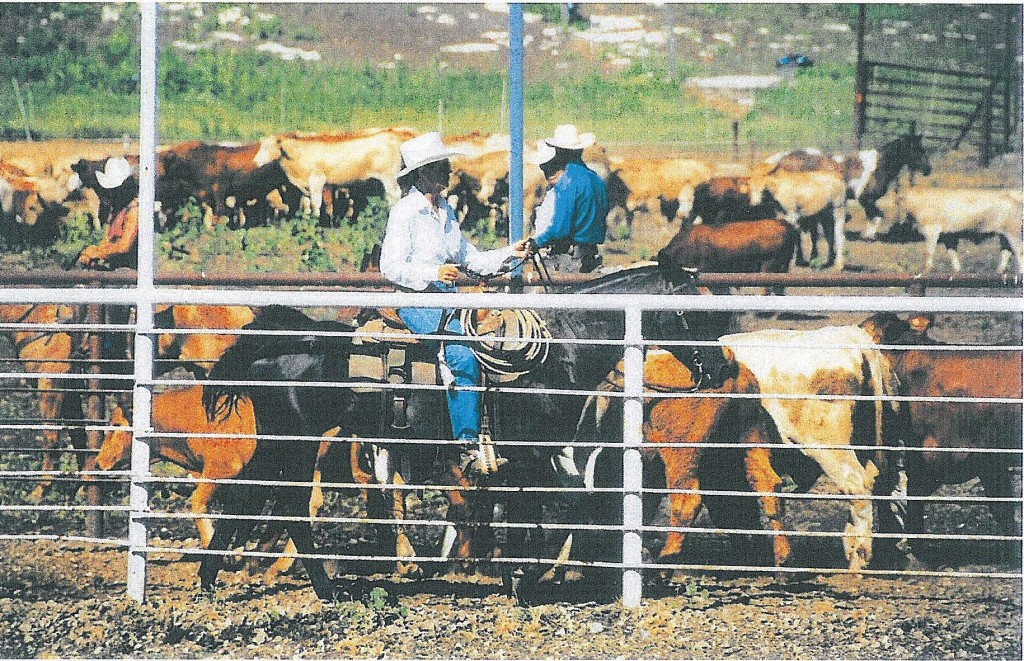
122.1 Guests at a working ranch
Economic Impacts of Tourism
123. Experiential tourism will allow communities in the Flint Hills to utilize existing resources, nature, culture, and history, to attract additional travelers. Nature tourism demonstrates exceptional adaptability to most economic cycles. During booms, international and long-haul markets can be targeted, and during recessions the focus can be geared down to regional, auto-travel.
124. Birding and other nature tourism development and promotion in other parts of the country have helped to make significant economic contributions to local communities. Bird watchers spent $7.4 billion nationwide in 2001 for food, lodging, transportation and other trip related expenses; and another $24.3 billion for wildlife watching equipment and other expenses according to the United States Fish & Wildlife Service.
125. According to Wilkerson (2003), “Given its historical performance as a luxury good during expansions and a necessity during recessions, travel and tourism’s future economic prospects look quite bright.” Traditional economic impacts from tourism are many, including the direct impact of visitor spending; the indirect changes in sales, income, or jobs in regional sectors that supply goods and services to the recreation/tourism industries; and the induced impact of increased sales within the region from the household spending of the income earned in the tourism and supporting sectors.
125.1 The Byway economic impact study estimated 1,025 visitor groups with an average size of 4.4 people visited the Tallgrass Prairie National Preserve during August 1998. This was further extrapolated to 41,000 individuals per year who tour the Byway.
125.2 Based upon the Byway economic impact study, it is conservatively estimated that each visitor group to the Flint Hills Tallgrass Prairie Region spent approximately $50/day/person on their trip. Using the 1994 statewide travel expenditure figure of $60/day/person and an annual regional visitation estimate of 41,000 people per year, the current direct expenditures by visitors to the region can be estimated at about $2.8 million adjusted for inflation over ten years annually.
125.3 In 2001, domestic travelers spent about $3.5 billion in Kansas. Nearly 55,000 jobs, with $872.8 million in wages and salaries, were supported by domestic travel spending in Kansas during 2001. Travel-generated jobs comprised 4.1% of the-total nonfarm employment in Kansas. Domestic travel spending in Kansas also generated $546.1 million in tax revenue for federal, state and local governments in 2001.
The Blue Ridge Parkway Experience
126. The Blue Ridge Parkway is a linear national park extending 469 miles from Shenandoah National Park in Virginia to Great Smoky Mountains National Park in North Carolina. The park is a scenic motor road designed by landscape architects to enable visitors to enjoy the scenic beauty of the region from their vehicles. Research indicates that the primary reason most visitors make a trip to the Parkway is to enjoy the views.
126.1 The Blue Ridge Parkway Scenic Experience Project was conducted in the summer and fall of 2002 as a collaborative project between the National Park Service, two universities, and an independent consultant. The study was designed to determine the benefits of the scenic experience and how change in the scenic quality would affect visitation; how much visitors would pay to preserve scenic quality; and how much they would pay to improve it. According to the National Park Service, in dollar terms, the scenic views along the Parkway in North Carolina are worth upwards of $5 billion a year to the visitors who enjoy them.
126.2 In 2002, more than 21.6 million recreation visits were made to the Blue Ridge Parkway making it the most visited national park unit in the United States.
Please continue to the next section of the complaint, a detailed description of the serious, permanent & irreparable damage wind turbines cause.
